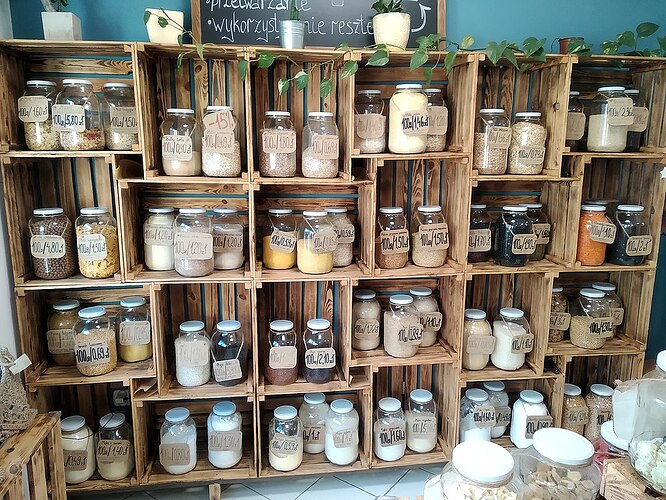The proposed shop=dry_food tag is equivalent to the concept of a dry goods store in most of the English-speaking world. These stores specialize in grains, preserved foods… the sort of thing you scoop out of a barrel.
In the U.S., stores in this retail category historically sold clothing and textiles as well. However, traditional dry goods stores are much less common than they used to be. In an urban area, some supermarkets have a bulk goods department for scooping foodstuff out of a bin.
Many remaining dry goods stores carry only dry food items and specialize in ethnic cuisines. There’s some overlap with shop=herbalist, shop=spices, shop=rice, shop=nuts, etc., but each of these tags is too limiting. I’ve been using shop=dry_food for ethnic dry goods stores for many years:
I’ve also tried using shop=deli for these stores, but I don’t think it’s a very good fit. The selection isn’t limited to gourmet foods; it typically includes much more mundane snacks. The term “deli” is already so overloaded in English that extending it to include these stores will stretch the tag past its breaking point.
For context, Americans colloquially use the term “grocery store” to refer to any unspecialized food retailer, but it formally only applies to the stores that don’t have a more specific term such as “supermarket”, “convenience store”, or “produce market” (i.e., greengrocer).
I’m pretty sure shop=grocery has always been used in the U.S. for what we would call a grocery store in a more formal sense. Nominatim has also supported this terminology since 2009 by calling it a “grocery shop”. However, in 2014, it was documented as a tagging mistake and deprecated in favor of shop=greengrocer, which contradicted this usage. (We have these too!) Someone soon pointed out that grocery stores are not the same as greengrocers but then proceeded to equate them with dry goods stores. A note distinguishing this tag from American grocery stores was added in 2009, but I think it confuses the colloquial and formal meanings of this term in American English.
The way I always understood it is that a supermarket has departments, such as a meat department, whereas a grocery store is too small to have dedicated departments. Another rule of thumb I use is based on how a customer manages their purchases as they wander around the store:
- At a wholesale store, you push a flatbed cart or, for smaller purchases, a shopping cart.
- At a supermarket or hypermarket, you either push a shopping cart or carry a shopping basket.
- At a grocery store or produce market, you either carry a shopping basket or carry everything in your hands.
- At a convenience store, you carry everything in your hands or, at a convenience store attached to a gas station, you only use the restroom and pay for gas.
You can easily see how these categories correspond to the store’s size without having to define a specific square footage. They also translate fairly well to the usual  and
and  POI icons. Tagging grocery stores as supermarkets is problematic because there’s a huge difference in selection, especially when it comes to ethnic grocery stores.
POI icons. Tagging grocery stores as supermarkets is problematic because there’s a huge difference in selection, especially when it comes to ethnic grocery stores.
“Dry food” isn’t an arbitrary category; it correlates to a specific kind of retailer that pulls together any and all dry goods. Some of the dry goods stores I’ve mapped also sell pickled foods in jars, but this doesn’t detract from their primary line of business.

